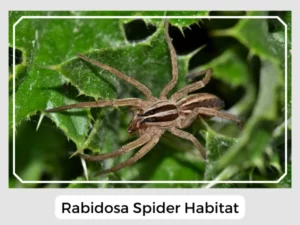Rabidosa spiders are part of the wolf spider family. Even though there are only five types, they’re pretty interesting! Found mainly in North America, these spiders have their own unique traits. Keep reading to uncover cool facts about them.
Female spiders make egg sacs with silk and then lay eggs in those cocoons.
After their hatching, spiderlings stay on the back of their mother until they become independent.
They do not make such webs; instead, they generate silk from their mouth to wrap their prey or even safeguard the eggs and spiderlings.
Yes, Rabidosa spiders have venom, but it’s mainly used to catch their prey.
Yes, Rabidosa spiders can bite if they feel threatened. However, the bite is usually not harmful to humans and causes minimal discomfort.
Rabidosa spiders play an important role in the ecological balance of their habitats. Primarily nocturnal, they are avid hunters, preying on a variety of insects and invertebrates. This not only helps in controlling the population of these smaller creatures but also establishes the spiders as crucial components of the food web in grassland ecosystems.
Natural Predator: Despite their prowess as predators, Rabidosa spiders are not without their own threats. Birds and larger arachnids pose a significant risk, preying on these spiders and keeping their populations in check. This predator-prey dynamic is essential for maintaining the delicate balance of ecosystems, ensuring that no single species dominates to the detriment of others.
Prey-Predator Dynamics: Rabidosa spiders exhibit remarkable hunting skills, relying on their speed and agility to capture prey. Their venom is a critical tool in this process, helping to immobilize their catch quickly. This dynamic interaction between predator and prey highlights the complexity of food webs, with Rabidosa spiders contributing to the biodiversity and stability of their environments.
Relationship with Humans: When it comes to interactions with humans, Rabidosa spiders are generally harmless. Though they are capable of biting if they feel threatened, their venom is not harmful to humans, resulting in minimal discomfort. As inhabitants of grasslands, these spiders are also indicators of the health of their ecosystems, making them valuable subjects of study for arachnologists and conservationists alike.
| Distribution | North America |
| Habitat | Grasslands |
| Diet | Insects and invertebrates |
| Lifespan | 1-2 years |

In summary, the Rabidosa spiders, with their distinctive features and behaviors, add a layer of complexity and intrigue to the rich tapestry of North American wildlife.
Rabidosa spiders are part of the wolf spider family. Even though there are only five types, they’re pretty interesting! Found mainly in North America, these spiders have their own unique traits. Keep reading to uncover cool facts about them.
Female spiders make egg sacs with silk and then lay eggs in those cocoons.
After their hatching, spiderlings stay on the back of their mother until they become independent.
They do not make such webs; instead, they generate silk from their mouth to wrap their prey or even safeguard the eggs and spiderlings.
Yes, Rabidosa spiders have venom, but it’s mainly used to catch their prey.
Yes, Rabidosa spiders can bite if they feel threatened. However, the bite is usually not harmful to humans and causes minimal discomfort.
Rabidosa spiders play an important role in the ecological balance of their habitats. Primarily nocturnal, they are avid hunters, preying on a variety of insects and invertebrates. This not only helps in controlling the population of these smaller creatures but also establishes the spiders as crucial components of the food web in grassland ecosystems.
Natural Predator: Despite their prowess as predators, Rabidosa spiders are not without their own threats. Birds and larger arachnids pose a significant risk, preying on these spiders and keeping their populations in check. This predator-prey dynamic is essential for maintaining the delicate balance of ecosystems, ensuring that no single species dominates to the detriment of others.
Prey-Predator Dynamics: Rabidosa spiders exhibit remarkable hunting skills, relying on their speed and agility to capture prey. Their venom is a critical tool in this process, helping to immobilize their catch quickly. This dynamic interaction between predator and prey highlights the complexity of food webs, with Rabidosa spiders contributing to the biodiversity and stability of their environments.
Relationship with Humans: When it comes to interactions with humans, Rabidosa spiders are generally harmless. Though they are capable of biting if they feel threatened, their venom is not harmful to humans, resulting in minimal discomfort. As inhabitants of grasslands, these spiders are also indicators of the health of their ecosystems, making them valuable subjects of study for arachnologists and conservationists alike.
| Distribution | North America |
| Habitat | Grasslands |
| Diet | Insects and invertebrates |
| Lifespan | 1-2 years |

In summary, the Rabidosa spiders, with their distinctive features and behaviors, add a layer of complexity and intrigue to the rich tapestry of North American wildlife.